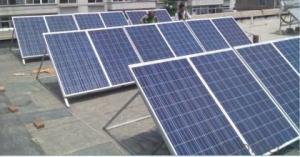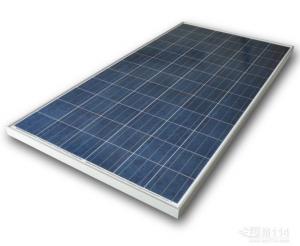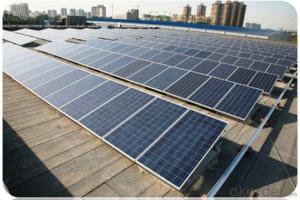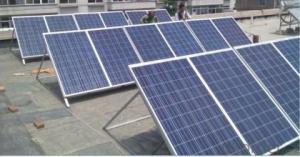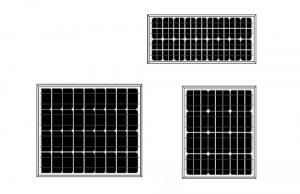Missouri Solar Panels - CNBM Solar Polycrystalline 6 Series (55-60W)
- Loading Port:
- China main port
- Payment Terms:
- TT OR LC
- Min Order Qty:
- 100000 watt
- Supply Capability:
- 10000000 watt/month
OKorder Service Pledge
OKorder Financial Service
You Might Also Like
Introduction
This installation Manual contains essential information for the electrical and mechanical installation that your must know before installing CUSTOMER PV modules. This also contains safety information you need to be familiar with .All the information described in this manual are the intellectual property of CNBM and based on the technologies and experiences that have been acquired and accumulated in the long history of CUSTOMER. This document does not constitute a warranty, expressed or implied.
CUSTOMER does not assume responsibility and expressly disclaims liability for loss, damage, or expense arising out of in anyway connected with installation, operation, use or maintenance of the PV modules. No responsibility is assumed by CUSTOMER for any infringement of patents or other rights of third parties that may result from use of PV module.
CUSTOMER reserves the right to make changes to the product, specifications or installation manual without prior notice.
Components

Data sheet
| Characteristics | |
| Max Power Voltage Vmp (V) | 17.4V-17.6V |
| Max Power Current Imp (A) | 3.17A-3.41A |
| Open Circuit Voltage Voc (V) | 22.4V-22.6V |
| Short Circuit Current Isc (A) | 3.38A-3.64A |
| Max Power Pm (W) | 55W-60W |
| Temperature Coefficient of Cells | |
| NOCT | 47℃±2℃ |
| Temperature Coefficients of Isc (%/℃) | 0.06% |
| Temperature Coefficients of Voc (%/℃) | -0.33% |
| Temperature Coefficients of Pmp (%/℃) | -0.45% |
| Mechanical Data | |
| Type of Cells (mm) | Poly156×62.4 |
| Dimension | 820×510×30mm |
| Weight | 4.9kg |
| NO.of Cells and Connections | 3×12=36 |
| Limits | |
| Operating Temperature | –45°C to +80°C |
| Storage Temperature | –45°C to +80°C |
| Max System Voltage | 700V |

FAQ:
1. How long will my inquiry get response?
Your inquiry related to our products or prices will be replied within 24 hours.
2. Can I get professional service and suggestion?
Well-trained and experienced staffs to answer all your questions in fluent English.
3. Do you accept OEM or customized design?
OEM & ODM, any your customized lightings we can help you to design and put into product.
4. What if I need specific design?
Distributorship are offered for your unique design and some our current models.
- Q: Can solar panels be installed on a data center or technology facility?
- Yes, solar panels can be installed on a data center or technology facility. In fact, many data centers and technology facilities are increasingly adopting solar power as a way to reduce their carbon footprint and lower energy costs. Solar panels can be installed on the rooftops or open spaces surrounding these facilities to generate clean, renewable energy that can be used to power their operations. Additionally, the excess energy produced by the solar panels can even be fed back into the grid, providing an additional source of revenue for the facility.
- Q: Are there any tax credits available for solar panel installation?
- Yes, there are tax credits available for solar panel installation. The federal government offers a solar Investment Tax Credit (ITC), which allows homeowners and businesses to deduct a percentage of the cost of installing solar energy systems from their federal taxes. Additionally, some states and local governments also offer their own tax incentives and credits for solar panel installation. It is advisable to check with your local tax authority to determine the specific credits available in your area.
- Q: Am using 800watts sukam inverter and have 55watts panel. What controller can i use to connect my solar system to have a max power . Already i have 200 Amp/hr battery
- Guide okorder /
- Q: Can solar panels be installed on a pergola or gazebo structure?
- Yes, solar panels can be installed on a pergola or gazebo structure. These structures provide a suitable platform for solar panel installation and can help maximize sunlight exposure for energy generation. Additionally, installing solar panels on a pergola or gazebo can serve a dual purpose by providing shade and generating clean, renewable energy.
- Q: Can solar panels be used in remote areas without access to the grid?
- Yes, solar panels can be used in remote areas without access to the grid. Solar panels generate electricity by capturing sunlight and converting it into usable energy. This renewable energy source is particularly useful in off-grid locations as it provides a sustainable and independent power supply. With advancements in solar technology and the availability of battery storage systems, solar panels can effectively meet the energy needs of remote areas, even during nighttime or periods of low sunlight. This makes solar panels an ideal solution for powering homes, businesses, and infrastructure in remote locations without grid connectivity.
- Q: How do I clean my solar panels?
- To clean your solar panels, start by checking the manufacturer's instructions as some panels may have specific cleaning requirements. Generally, you can clean them by gently rinsing with water using a hose or a bucket and sponge. Avoid using abrasive materials or harsh chemicals that could damage the panels. If there's stubborn dirt or debris, you can use a mild soap solution with a soft brush to gently scrub the surface. Regularly cleaning your solar panels will help to maintain their efficiency and ensure optimal energy production.
- Q: Can solar panels be installed on historical landmarks or monuments?
- Yes, solar panels can be installed on historical landmarks or monuments with careful planning and consideration to preserve the architectural integrity and cultural significance of the site.
- Q: Can solar panels be used in areas with high levels of heatwaves?
- Yes, solar panels can be used in areas with high levels of heatwaves. In fact, solar panels can still generate electricity in extreme heat, although their efficiency may decrease slightly due to the temperature increase. However, it's worth noting that high temperatures can also lead to increased energy consumption for cooling, which may offset the benefits of solar energy to some extent. Nevertheless, solar panels remain a viable and sustainable solution for electricity generation in areas with high levels of heatwaves.
- Q: Can solar panels be installed on mobile homes?
- Yes, solar panels can be installed on mobile homes. In fact, mobile homes can be great candidates for solar panel installations due to their smaller size and affordability. Additionally, solar panels can help mobile homeowners save on electricity bills and reduce their carbon footprint.
Send your message to us
Missouri Solar Panels - CNBM Solar Polycrystalline 6 Series (55-60W)
- Loading Port:
- China main port
- Payment Terms:
- TT OR LC
- Min Order Qty:
- 100000 watt
- Supply Capability:
- 10000000 watt/month
OKorder Service Pledge
OKorder Financial Service
Similar products
Hot products
Hot Searches
Related keywords


